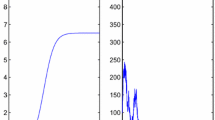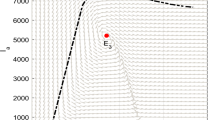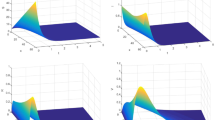Abstract
To assess the comprehensive impact of intervention strategies and available hospital resources, in this paper we first propose an avian influenza model with nonlinear incidence and recovery rates and investigate the local and global stability of the feasible equilibria. Taking into account the inherent randomness of the growth and spread of epidemics, we then extend the model into a random scenario and study the persistence, extinction and the existence of ergodic stationary distribution of the stochastic model. Finally, we numerically illustrate the obtained results. Both theoretical and numerical results show that: (i) Whether the avian influenza disappears or not depends entirely on the threshold in deterministic or random environment; (ii) Adequate hospital resources, government interventions and noise may suppress the outbreak of avian influenza virus; and (iii) Using multiple control strategies simultaneously is more effective in reducing the number of infections than using a single strategy.






Similar content being viewed by others
Data availability
Data sharing is not applicable to this article as no datasets were generated or analyzed during the current study.
References
Swayne, D.E.: Animal Influenza, 2nd edn. Wiley-Blackwell, Iowa (2016)
Xue, K., Moncla, L.H., Bedford, T., Bloom, J.D.: Within-host evolution of human influenza virus. Trends Microbiol. 26(9), 781–793 (2018)
Centers for Disease Control and Prevention (CDC), Avian Influenza. https://www.cdc.gov/flu/avianflu/bird-flu-basics.htm
Sooryanarain, H., Elankumaran, S.: Environmental role in influenza virus outbreaks. Annu. Rev. Anim. Biosci. 3, 347–373 (2015)
World Health Organization, Cumulative number of confirmed human cases of avian influenza A (H5N1) reported to WHO. http://www.who.int/influenza/human_animal_interface/H5N1_cumulative_table_archives/en/
Shen, Y., Lu, H.: Global concern regarding the fifth case of human infection with avian influenza A (H7N9) virus in China. Biosci. Trends 11(1), 120–121 (2017)
Yu, H., Wu, J., Cowling, B.J., et al.: Impact of live poultry market closure in reducing bird-to-human transmission of avian influenza A(H7N9) virus: an ecological study. Lancet 383(9916), 541–548 (2014)
Yuan, J., Lau, E.H.Y., Li, K., et al.: Effect of live poultry market closure on avian influenza A(H7N9) virus activity in Guangzhou, China, 2014. Emerg. Infect. Dis. 21(10), 1784–1793 (2015)
Iwami, S., Takeuchi, Y., Liu, X.: Avian-human influenza epidemic model. Math. Biosci. 207(1), 1–25 (2007)
Iwami, S., Takeuchi, Y., Liu, X.: Avian flu pandemic: can we prevent it? J. Theor. Biol. 257(1), 181–190 (2009)
Lee, J., Kim, J., Kwon, H.D.: Optimal control of an influenza model with seasonal forcing and age-dependent transmission rates. J. Theor. Biol. 317, 310–320 (2013)
Jaberi-Douraki, M., Moghadas, S.M.: Optimal control of vaccination dynamics during an influenza epidemic. Math. Biosci. Eng. 11(5), 1045–1063 (2014)
Wang, L., Liu, Z., Xu, D., Zhang, X.: Global dynamics and optimal control of an influenza model with vaccination, media coverage and treatment. Int. J. Biomath. 10(5), 1750068 (2017)
Bourouiba, L., Gourley, S.A., Liu, R., Wu, J.: The interaction of migratory birds and domestic poultry and its role in sustaining avian influenza. SIAM J. Appl. Math. 71(2), 487–516 (2011)
Liu, S., Ruan, S., Zhang, X.: On avian influenza epidemic models with time delay. Theor. Biosci. 134, 75–82 (2015)
Chen, C., Wang, P., Zhang, L.: A two-thresholds policy for a Filippov model in combating influenza. J. Math. Biol. 81, 435–461 (2020)
Chong, N., Smith, R.: Modeling avian influenza using Filippov systems to determine culling of infected birds and quarantine. Nonlinear Anal-Real. 24, 196–218 (2015)
Xiao, Y., Tang, S., Wu, J.: Media impact switching surface during an infectious disease outbreak. Sci. Rep. 5, 7838 (2015)
Chen, C., Chong, N., Smith, R.: A Filippov model describing the effects of media coverage and quarantine on the spread of human influenza. Math. Biosci. 296, 98–112 (2018)
Liu, S., Ruan, S., Zhang, X.: Nonlinear dynamics of avian influenza epidemic models. Math. Biosci. 283, 118–135 (2017)
Liu, S., Pang, L., Ruan, S., Zhang, X.: Global dynamics of avian influenza epidemic models with psychological effect. Comput. Math. Method. M. 2015, 913726 (2015)
Funk, S., Salathé, M., Jansen, V.A.A.: Modelling the influence of human behaviour on the spread of infectious diseases: a review. J. R. Soc. Interface 7(50), 1247–1256 (2010)
Xiao, D., Ruan, S.: Global analysis of an epidemic model with nonmonotone incidence rate. Math. Biosci. 208(2), 419–429 (2007)
Mu, R., Wei, A., Yang, Y.: Global dynamics and sliding motion in A(H7N9) epidemic models with limited resources and Filippov control. J. Math. Anal. Appl. 477(2), 1296–1317 (2019)
Wang, W., Ruan, S.: Bifurcations in an epidemic model with constant removal rate of the infectives. J. Math. Anal. Appl. 291(2), 775–793 (2004)
Zhao, H., Wang, L., Oliva, S., Zhu, H.: Modeling and dynamics analysis of Zika transmission with limited medical resources. B. Math. Biol. 82(8), 99 (2020)
Shan, C., Zhu, H.: Bifurcations and complex dynamics of an SIR model with the impact of the number of hospital beds. J. Differ. Eq. 257(5), 1662–1688 (2014)
Abdelrazec, A., Bélair, J., Shan, C., Zhu, H.: Modeling the spread and control of dengue with limited public health resources. Math. Biosci. 271, 136–145 (2016)
Zhang, J., Jin, Z., Sun, G., Sun, X., Wang, Y., Huang, B.: Determination of original infection source of H7N9 avian influenza by dynamical model. Sci. Rep. 4, 4846 (2014)
Spencer, S.: Stochastic Epidemic Models For Emerging Diseases, PhD thesis. University of Nottingham (2011)
Beddington, J.R., May, R.M.: Harvesting natural populations in a randomly fluctuating environment. Science 197, 463–465 (1977)
Zhang, X.: Global dynamics of a stochastic avian-human influenza epidemic model with logistic growth for avian population. Nonlinear Dyn. 90, 2331–2343 (2017)
Zhang, F., Zhang, X.: The threshold of a stochastic avian-human influenza epidemic model with psychological effect. Physica A 492, 485–495 (2018)
Shi, Z., Zhang, X., Jiang, D.: Dynamics of an avian influenza model with half-saturated incidence. Appl. Math. Comput. 355, 399–416 (2019)
Yu, X., Yuan, S., Zhang, T.: The effects of toxin-producing phytoplankton and environmental fluctuations on the planktonic blooms. Nonlinear Dyn. 91, 1653–1668 (2018)
Xu, C., Yuan, S., Zhang, T.: Competitive exclusion in a general multi-species chemostat model with stochastic perturbations. B. Math. Biol. 83, 4 (2021)
Zhao, S., Yuan, S., Wang, H.: Threshold behavior in a stochastic algal growth model with stoichiometric constraints and seasonal variation. J. Differ. Eq. 268(9), 5113–5139 (2020)
Driessche, P., Watmough, J.: Reproduction numbers and sub-threshold endemic equilibria for compartmental models of disease transmission. Math. Biosci. 180, 29–48 (2002)
Gray, A., Greenhalgh, D., Hu, L., Mao, X., Pan, J.: A stochastic differential equation SIS epidemic model. SIAM J. Appl. Math. 71(3), 876–902 (2011)
Mao, X.: Stochastic Differential Equations and Applications. Horwood Publishing, Chichester (1997)
Lipster, R.: A strong law of large numbers for local martingales. Stochastics 3, 217–228 (1980)
Liu, M., Bai, C.: Analysis of a stochastic tri-trophic food-chain model with harvesting. J. Math. Biol. 73, 597–625 (2016)
Yang, Q., Jiang, D., Shi, N., Ji, C.: The ergodicity and extinction of stochastically perturbed SIR and SEIR epidemic models with saturated incidence. J. Math. Anal. Appl. 388(1), 248–271 (2012)
Khasminskii, R.: Stochastic Stability of Differential Equations. Springer-Verlag, Berlin (2012)
Allen, L.: An Introduction to Mathematical Biology. Prentice-Hall, New Jersey (2006)
Funding
This work is supported by the National Natural Science Foundation of China (No. 12171441), the Key Scientific Research Project of Colleges and Universities of Henan Province (No. 21A110024) and the Science and Technology Research Project of Henan Province (No. 222102320432).
Author information
Authors and Affiliations
Corresponding author
Ethics declarations
Conflict of interest
The authors declare that they have no conflict of interest.
Additional information
Publisher's Note
Springer Nature remains neutral with regard to jurisdictional claims in published maps and institutional affiliations.
Appendices
Appendix A
Proof
In fact, it follows from (4) that
- (i):
-
If \(e_1\le 0\), then there is only one sign change in the coefficients of f(x). By Descartes’ Rule of Signs [45], \(f(x)=0\) has a unique positive root;
- (ii):
-
If \(e_1>0\), then
$$\begin{aligned}&f'(x)=4e_4x^3+3e_3x^2+2e_2x+e_1,\\&f(0)=e_0>0,\ f(+\infty )=-\infty . \end{aligned}$$
Clearly, there is only one sign change in the coefficients of \(f'(x)\). Similarly, Descartes’ Rule of Signs [45] implies that \(f'(x)=0\) has a unique positive root denoted by \(x_+\). This, together with \(f'(0)=e_1>0\) and \(f'(+\infty )=-\infty \), yields that
Thus, f(x) is increasing for \(0\le x<x_+\) and is decreasing for \(x\ge x_+\), showing that Eq. (4) has a unique positive root. \(\square \)
Appendix B
Proof
Assume that \(\epsilon \) meets the following conditions:
where \(\varPhi _i\) \((i=1, \ldots , 5)\), \(\varUpsilon \) are defined as (B.10)-(B.15). For convenience, we then divide \({\mathbb {R}}_+^5\backslash U_{\epsilon }\) into \({\mathbb {R}}_+^5\backslash U_{\epsilon }=\bigcup _{k= 1}^{10}U_{\epsilon }^k\), where
We just need to prove \({\mathcal {L}}V_4\le -1\) in each \(U_{\epsilon }^k,\ k=1, \cdots , 10\), which means in \({\mathbb {R}}_+^5\backslash U_{\epsilon }\).
- Case 1::
-
If \(X(t)\in U_{\epsilon }^1\), by (24) and (B.1), then
$$\begin{aligned} {\mathcal {L}}V_{4}\le&M\beta _a(b+m_2)(\frac{3}{7}S_a^{\frac{7}{3}}+\frac{4}{7}I_a^{\frac{7}{4}})+\sum \limits _{i=1}^5H_i\\ \le&-\frac{r_a}{2K_a}\frac{1}{{\epsilon }^3}+\varPhi _1\le -1, \end{aligned}$$where
$$\begin{aligned}&\varPhi _1=\sup \limits _{X(t)\in {\mathbb {R}}_+^5}\{M\beta _a(b+m_2)(\frac{3}{7}S_a^{\frac{7}{3}} +\frac{4}{7}I_a^{\frac{7}{4}})\nonumber \\&\quad +\frac{r_a}{2K_a}S_a^3+\sum \limits _{i=1}^5H_i\}<\infty . \end{aligned}$$(B.10)
If \(X(t)\in U_{\epsilon }^2\), then it follows from (24) and (B.2) that
where
If \(X(t)\in U_{\epsilon }^3\), then (24) and (B.3) imply that
where
If \(X(t)\in U_{\epsilon }^4\), then it can be seen from (24) and (B.4) that
where
If \(X(t)\in U_{\epsilon }^5\), by (24) and (B.5), then
where
- Case 2::
-
If \(X(t)\in U_{\epsilon }^6\), using (24), (B.6) and the definitions of M and \(\phi _1\), then
$$\begin{aligned} {\mathcal {L}}V_{4}&\le -M(\mu _a+\delta _a+\frac{1}{2}\sigma _2^2)({\mathcal {R}}_0^S-1)\\&\quad -\beta _a(b+m_2)(1-M\epsilon )I_a\\&+\beta _a(b+m_2)I_a+\sum \limits _{i=1}^5H_i\\&\le -M(\mu _a+\delta _a+\frac{1}{2}\sigma _2^2)({\mathcal {R}}_0^S-1)\\&\quad -\beta _a(b+m_2)(1-M\epsilon )I_a+\phi _1\\&\le -\frac{1}{2}M(\mu _a+\delta _a+\frac{1}{2}\sigma _2^2)({\mathcal {R}}_0^S-1)\le -1. \end{aligned}$$Similarly, if \(X(t)\in U_{\epsilon }^7\), then we also have
$$\begin{aligned} {\mathcal {L}}V_{4}&\le -M(\mu _a+\delta _a+\frac{1}{2}\sigma _2^2)({\mathcal {R}}_0^S-1)\\&\quad -\beta _a(b+m_2)(1-M\epsilon )S_a+\phi _2\\&\le -\frac{1}{2}M(\mu _a+\delta _a+\frac{1}{2}\sigma _2^2)({\mathcal {R}}_0^S-1)\le -1. \end{aligned}$$ - Case 3::
-
If \(X(t)\in U_{\epsilon }^8\), using (24) and (B.7), then
$$\begin{aligned} {\mathcal {L}}V_{4} \le&-M(\mu _a+\delta _a+\frac{1}{2}\sigma _2^2)({\mathcal {R}}_0^S-1)\\&\quad -\frac{\varPi _h}{\epsilon }+\varUpsilon \le -1, \end{aligned}$$where
$$\begin{aligned} \varUpsilon= & {} \sup \limits _{X(t)\in {\mathbb {R}}_+^5}\{M\beta _a(b+m_2)S_aI_a\nonumber \\&+\sum \limits _{i=1}^5H_i\}<\infty . \end{aligned}$$(B.15)
If \(X(t)\in U_{\epsilon }^9\), applying (24) and (B.8), then
If \(X(t)\in U_{\epsilon }^{10}\), by (24) and (B.9), then
In short, we have \({\mathcal {L}}V_4\le -1\) on \({\mathbb {R}}_+^5\backslash U_{\epsilon }\). \(\square \)
Rights and permissions
About this article
Cite this article
Yu, X., Ma, Y. An avian influenza model with nonlinear incidence and recovery rates in deterministic and stochastic environments. Nonlinear Dyn 108, 4611–4628 (2022). https://doi.org/10.1007/s11071-022-07422-6
Received:
Accepted:
Published:
Issue Date:
DOI: https://doi.org/10.1007/s11071-022-07422-6




